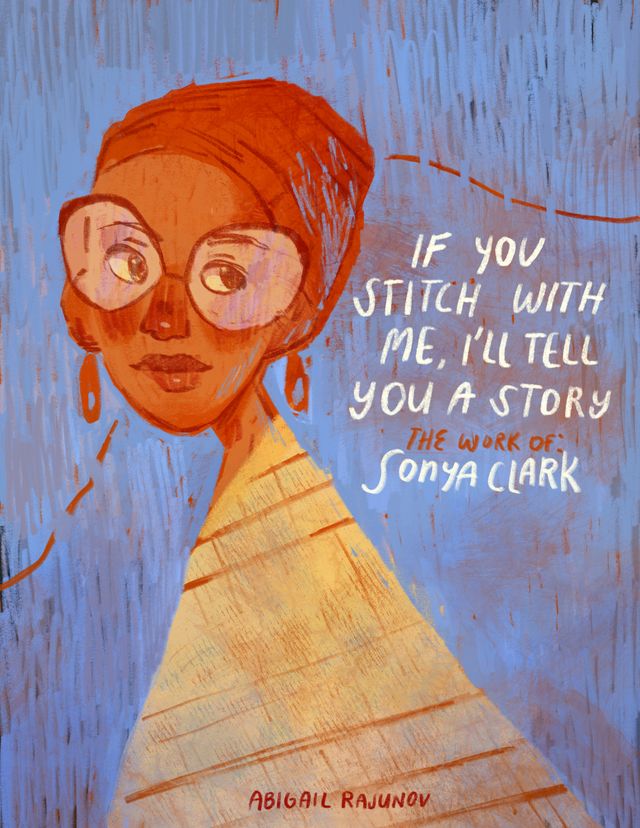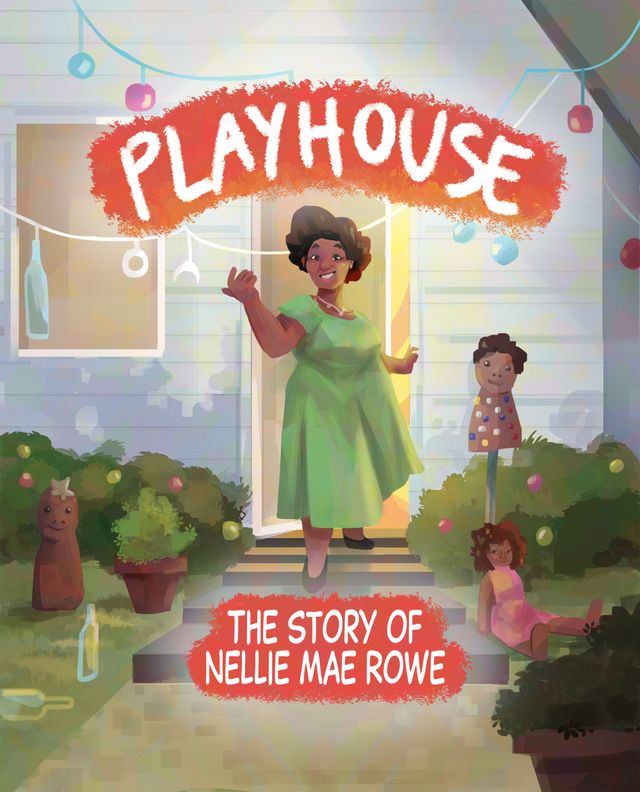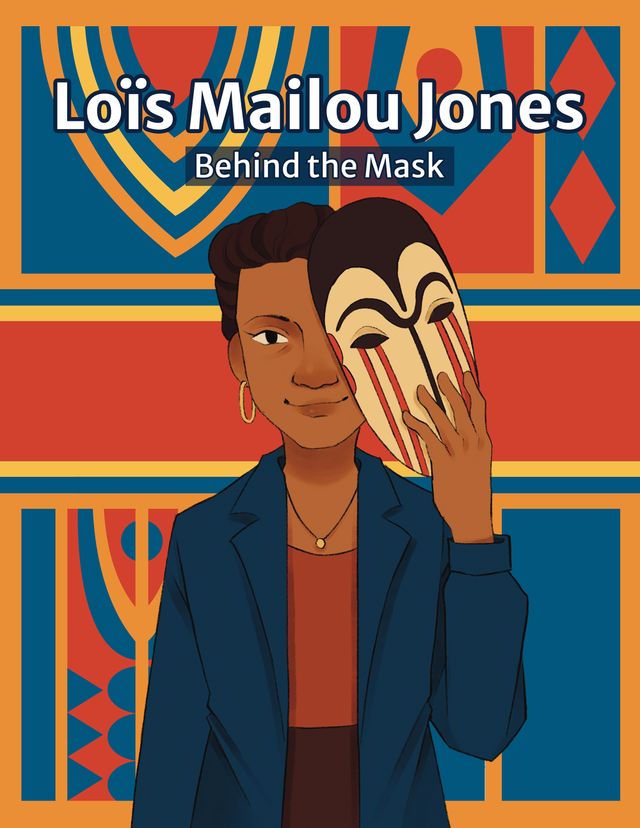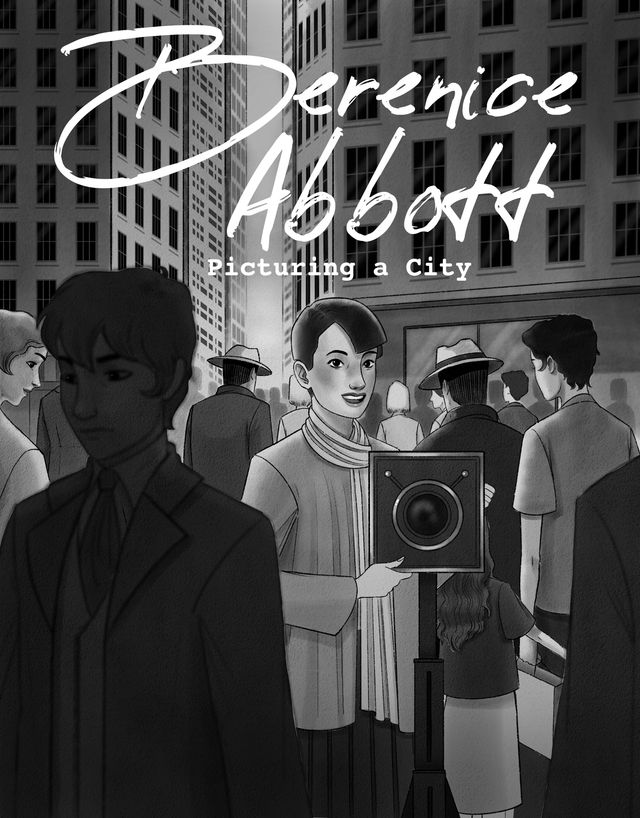An Overview
Painter and printmaker Barbara Jones-Hogu was a founding member of the African Commune of Bad Relevant Artists (AfriCOBRA), an artist collective formed in Chicago in 1968. Members of AfriCOBRA visually expressed the central ideas of the Black Power movement—self-determination, unity, and black pride. The artist’s groundbreaking prints spoke to the Black Power movement and were an integral part of the political and social conversations of the 1960s and 1970s.
This comic is part of a series Drawn to Art: Tales of Inspiring Women Artists that illuminates the stories of women artists in the collection of the Smithsonian American Art Museum. Inspired by graphic novels, these short takes on artists’ lives were each drawn by a student-illustrator from the Ringling College of Art and Design.
We invite you to read the comic and share it with your friends and young people in your life.

Cover
The top of the page is black with "Barbara Jones-Hogu" written in white text. Under this, there is an illustration of a woman with a dark skin tone and a black afro wearing a black shirt standing in the middle of a group of raised dark and medium brown fists. Behind the fists are yellow and purple diagonal stripes. Below this illustration, the word “Unite” is written in red with a blue background, the text gradually getting larger toward the end of the word.

Page 1
Background: There are four panels on this page, one in the upper left, one in the upper right, one along the middle third, and one on the bottom third of the page. The top of page has light blue, orange, and black streaks behind the top two panels. There are four yellow text boxes with black text.
Panel 1
A hand with a dark skin tone reaches in from the left corner of the panel against a blue-gray backdrop. It runs a printmaking tool across a red silkscreen. Text reads: "Born in Chicago in 1938, Barbara Jones-Hogu came to printmaking almost by accident. She went on to use the medium to create some of the most iconic visual art of the Black Arts Movement."
Panel 2
A young Barbara Jones-Hogu stands on the right side of the panel. She looks down, holding a large purple and red silkscreen print up over the cream table in front of her. She is wearing a green shirt, an orange apron, and black gloves. Text reads: "Barbara's original focus was painting, which she studied at the Art Institute of Chicago. She shifted to printmaking as a grad student at the nearby Institute of Design after her teacher gave her a key to the print studio so she could work there after hours."
Panel 3
Barbara Jones-Hogu and three other young people with medium and dark skin tones sit and talk at a wooden table. On the left is a woman looking to her right. She has a brown afro and is wearing an orange collared shirt with a blue vest on top. Next to her is a woman with brown curly hair in a bun, wearing a green headband and green tank top, who is gesturing while talking to the people to the right. Barbara sits in the middle wearing a short-sleeved blue shirt and has her arms crossed resting on the table in front of them. To the right is a man with short black hair who is wearing a light blue collared short-sleeved shirt. He rests his arm on the table and looks at the woman in the green who is speaking. The wooden table in front of them has sketchbooks and pencils on it. Text reads: "While still a student, she became a member of the visual arts workshop of the Organization of Black American Culture (OBAC) and helped to paint the mural Wall of Respect in 1967."
Panel 4
Barbara Jones-Hogu stands at the right of the page, painting a figure on the theater section of the mural, Wall of Respect. She is facing away from the viewer with her left hand raised to the wall holding a paint brush and is wearing a flowing green dress. To the left of her is an illustration of the Wall of Respect, including sketched renderings of portraits of famous Black Americans. Text reads: "The large-scale two-story community mural was painted on the outside of a former tavern on the South Side of Chicago, in a neighborhood sometimes referred to as the 'Black Belt.' It pays tribute to prominent African Americans including Harriet Tubman, Muhammad Ali, and Aretha Franklin. Barbara painted the theater section, including portraits of Cicely Tyson and Ossie Davis, among others."

Page 2
Background: This page is broken into 6 panels, one on the left top, middle, and bottom of the page, and one on the right top, middle, and bottom of the page. There are five green text boxes with black text. The background of the top half is light and medium teal swirls. The background of the bottom half has similar stripes, but in dark orange, dark pink, medium yellow, and the same green used in the text boxes.
Panel 1
A young Barbara Jones-Hogu stands in front of two young men with medium and dark skin tones and black hair holding picket signs. Behind them are more people with signs who fade into a purple background. Barbara waves a yellow piece of paper in front of her, with her mouth open and her brow furrowed. She is wearing a blue jacket with colorful buttons on the left lapel and a yellow shirt. Under the panel three dark and medium skin-toned fists reach out towards the text panel. Text reads: "Chicago was a hub of Black political and cultural activism and important to the Black power movement nationwide. Barbara was engaging with these ideas and becoming a figure in the Black arts scene of Chicago."
Panel 2
The African continent is drawn simply in an orange-brown tone with the word "AfriCOBRA" written across it in black. Text reads: "The following year, she became a founding member of AfriCOBRA, an artist collective whose goal was to create art that reflects Black culture and speaks to Black audiences. Its name stands for 'African Commune of Bad Relevant Artists.'"
Panel 3
Barbara sits against a purple background in front of a wooden table covered in scattered paper. She is wearing a yellow headband and tan shirt and is sitting in a wooden chair. Her right arm is propped on the table in front of her and she rests her head in her hand, which also holds a paint brush. She gestures to the viewer with her left hand. A green text bubble is coming out of her mouth. Text reads: "'The people we were making art for looked like us,' Barbara said."
Panel 4
Barbara leans over a silkscreen printing press and rubs a printmaking tool across an orange and yellow surface. She is wearing a yellow headband, green dress, and orange apron. Bright lilac pieces of paper fly across the page, getting larger as they approach the viewer. Text reads: "Barbara's knowledge of silkscreen technique was crucial to AfriCOBRA's success, as the collective turned to printmaking as a potent means of getting their message out. 'There were a lot of painters in AfriCOBRA, so printmaking set me apart from them.'"
Panel 5
Barbara looks down at the text box below her, running a paintbrush across the top. She is wearing a navy apron and white shirt, with her hair in a circular afro. Behind her are dark pink, orange, and yellow stripes. Text reads: "In AfriCOBRA, she was known for adding text to her prints; in fact, she was the first in the collective to do so. Her prints were known for their bold lettering and color, reflecting the core tenets of AfriCOBRA aesthetics, including luminosity, rhythm, humanism, and making a direct statement."
Panel 6
With her right hand, Barbara holds a paint brush up to the colorful striped background, painting the words "To be Free, Know the Past" onto it. She is wearing a light blue mock-neck tank top, emerging between the striped background. Behind her is a circular orange orb with dark pink strokes that evoke facial features.

Page 3
Background: This page is broken into three panels, one in the top left, one in the top right, and one larger panel covering the rest of the page. There are three light blue text boxes with black text. The background of the top half of the page is a gradient of yellow stripes. The bottom half of the page is the same, but layered with dark pink, light blue, and light orange diagonal strokes.
Panel 1
Five figures with medium and dark skin tones and short black hair stand facing the viewer. In the front, there is a young woman with a white tank top dress and orange headband with her arms crossed. She is next to a woman in a pink long-sleeve shirt and blue jeans, holding a child wearing a red and navy stripped top. Behind these women there is a young man with a short-sleeved white-collared shirt, striped vest, and blue jeans, an older woman in a lilac ruffled dress, and a middle-aged man with a beard in a mauve collared shirt with a brown vest and blue jeans. Text reads: "The founders of AfriCOBRA believed that artists have a role in changing society and that they should create images that promote Black self-determination, pride, and empowerment. This stood in stark contrast to damaging, racist representations of Black Americans prevalent in mainstream culture at the time."
Panel 2
There is a rendering of the print "Unite" by Barbara Jones-Hogu. The print includes the word "unite" written repeatedly in red, blue, purple, and light pink. In front of the text stand a large group of people with medium and dark skin tones raising their fists. Text under the image reads: "Barbara's iconic print Unite was inspired by her visit to her friend, sculptor Elizabeth Catlett in Mexico in 1968. Barbara was drawn to Catlett's sculpture, Black Unity, which depicts a raised fist – a powerful symbol for social and political change. This echoed a powerful moment at the Olympics when two Black athletes from the U.S., Tommie Smith, and John Carlos, raised their fists in protest during the national anthem."
Panel 3
There is a drawing of Tommie Smith and John Carlos on the white medal podium at the Olympics. The two men have dark skin tones and short black hair and facial hair. They are wearing black tracksuits, and each have a raised, gloved fist in the air. Behind them is a drawing of Elizabeth Catlett's sculpture "Black Unity" which is a simplified dark brown fist. Text reads: "Unite combines strong silhouettes and vibrant color with inspiring text. AfriCOBRA created copies to circulate in the community as part of their message of Black pride, hope, and social justice. It’s an image that calls on Black people to embrace the freedom struggle and to unite."

End Page
Royal purple in the middle two thirds of the page fades into a textured yellow at the bottom. Streaky golden yellow strokes fan out behind the center image. In the center, a wooden printmaking tool sits on top of a red, navy, gray silkscreen print. White handwritten text under the image reads: "Illustrated by Zahra Merchant."

































